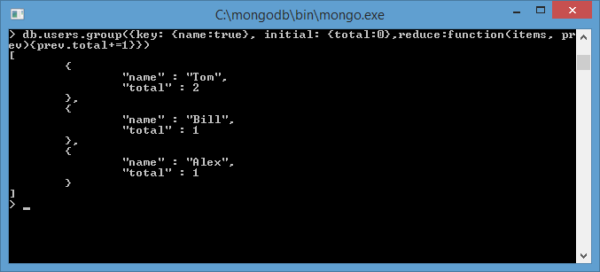REQUEST COMPLIMENTARY SQLS*PLUS LICENCE
MongoDB: count, group, distinct

MongoDB grouping commands: count, group, distinct should be considered separately.
Number of items in the collection
With the count() function you can get the number of elements in the collection:
db.users.count()
You can group the search options and the count function to calculate how many specific documents, such as those with name=Tom:
db.users.find({name: "Tom"}).count()
Moreover, we can create chains of functions to concretize the counting conditions:
db.users.find({name: "Tom"}).skip(2).count(true)
It should be noted here that by default the count function is not used with the limit and skip functions. To use them, as in the above example, the Boolean value true must be passed to the count function.
MongoDB Function
A collection may have documents that contain the same values for one or more fields. For example, several documents have a name: “Tom”. And we need to find only unique, different values for one of the fields of the document. To do this, we can use a distinct function:
db.users.distinct("name")
["Tom", "Bill", "Bob"]
Here I request only unique values for the name field. And on the next line, the console outputs the found unique values as an array.
MongoDB Grouping and the group method
Using the group method is similar to using GROUP BY expression in SQL. The group method accepts three parameters:
- key: indicates the key on which the grouping should be performed
- initial: initializes the fields of the document that will represent the group of documents
- reduce: represents a function that returns the number of elements. This function takes as its arguments two parameters: the current element and the aggregate result document for the current group
- keyf: an optional parameter. It is used instead of the key parameter and represents a function that returns a key object
- cond: optional parameter. It is a condition that should return true, otherwise, the document will not take part in the grouping. If this option is not specified, all documents will be grouped.
This parameter is optional. Represents a function that is triggered before the grouping results are returned.
For example:
db.users.group ({key: {name : true}, initial: {total : 0},
reduce : function (curr, res){res.total += 1}})
Let’s parse the expression. The key parameter indicates that the grouping will be performed with the key name: key: {name: true}.
The value of the initial parameter initializes the fields of the resulting document that will represent the group. Thus, in this case, the initial value of the total field is set. This field will represent the number of elements for the group. And since there may be no elements, we initialize it with zero.
The parameter reduction represents a function where curr refers to the current object in the group, and res represents the current group. If another object with a certain value for the name field is found, this document is added to the group, and the value of total is increased by one in the res document.

As can be seen from the screenshot, there are two documents in the user’s collection with name=Tom, and one document each with name=Alex and name=Bill.
When using grouping, you should consider that the group function does not work in sharded clusters. In this case, the map-reduce function should be used instead of the group function.
Aggregation Example: $group and $count – MongoDB Aggregation Tutorial
MORE NEWS
PreambleNoSql is not a replacement for SQL databases but is a valid alternative for many situations where standard SQL is not the best approach for...
PreambleMongoDB Conditional operators specify a condition to which the value of the document field shall correspond.Comparison Query Operators $eq...
5 Database management trends impacting database administrationIn the realm of database management systems, moreover half (52%) of your competitors feel...
The data type is defined as the type of data that any column or variable can store in MS SQL Server. What is the data type? When you create any table or...
PreambleMS SQL Server is a client-server architecture. MS SQL Server process starts with the client application sending a query.SQL Server accepts,...
First the basics: what is the master/slave?One database server (“master”) responds and can do anything. A lot of other database servers store copies of all...
PreambleAtom Hopper (based on Apache Abdera) for those who may not know is an open-source project sponsored by Rackspace. Today we will figure out how to...
PreambleMongoDB recently introduced its new aggregation structure. This structure provides a simpler solution for calculating aggregated values rather...
FlexibilityOne of the most advertised features of MongoDB is its flexibility. Flexibility, however, is a double-edged sword. More flexibility means more...
PreambleSQLShell is a cross-platform command-line tool for SQL, similar to psql for PostgreSQL or MySQL command-line tool for MySQL.Why use it?If you...
PreambleWriting an application on top of the framework on top of the driver on top of the database is a bit like a game on the phone: you say “insert...
PreambleOracle Coherence is a distributed cache that is functionally comparable with Memcached. In addition to the basic function of the API cache, it...
PreambleIBM pureXML, a proprietary XML database built on a relational mechanism (designed for puns) that offers both relational ( SQL / XML ) and...
What is PostgreSQL array? In PostgreSQL we can define a column as an array of valid data types. The data type can be built-in, custom or enumerated....
PreambleIf you are a Linux sysadmin or developer, there comes a time when you need to manage an Oracle database that can work in your environment.In this...
PreambleStarting with Microsoft SQL Server 2008, by default, the group of local administrators is no longer added to SQL Server administrators during the...















